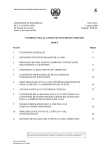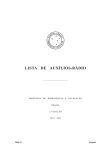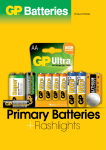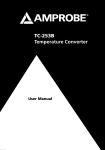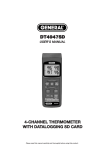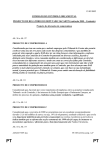Download Learning Resources GeoSafari Motorized Solar System
Transcript
® EI-5237 Ages 8+ Grades 3+ dwarf planet included ® The Motorized Solar System and Planetarium takes the abstract concept of the solar system and brings it to life with light and motion. The activities make for a powerful, hands-on learning experience. To teach students about stars and constellations, use the star dome to transform any classroom into a planetarium. Includes: • central tower • eight planet orbs plus one dwarf planet orb with identifying planetary symbols* • nine metal rods, one for each of the eight planets plus one for Pluto • sun sphere (with symbol) • Northern Hemisphere star dome • krypton bulb** * see table on page 4 ** instructions for use on back cover Assembling the Solar System Model Before starting, place four C-size batteries in the battery compartment. See back cover of this guide for instructions. 1. Insert the krypton bulb into the center tower’s inner socket. Place the white plastic casing over the bulb, pushing down and rotating the casing until it locks. Fit the sun sphere over the bulb. 2. Attach the shortest rod to Mercury, the closest planet to the sun. Insert this rod into the top ring of the central tower. 3. Attach the next shortest rod to Venus, and insert the rod and planet into the second ring from the top. Continue in this fashion until all rods and planets have been assembled and attached to the tower. If you choose to include Pluto, it should be at the bottom of the tower with the longest rod. Each planet is printed with its own planetary symbol. For correct order, refer to the first three columns of the chart on page 4. They list each planet’s name, symbol, and position in relation to the sun. 4. Once you have assembled the model, position the planets within their orbits by following the directions in the section “Where Are the Planets Now?” While you may wish to arrange them yourself for your initial lesson, the process also makes an excellent group activity. For directions on using the star dome, see page 5. Introducing the Solar System Model in the Classroom Observing the Solar System in Action Seeing the model in action—revolving, with the light on—is a good starting point for students to learn about the solar system. If looking over the model from the sun’s north pole, the planets orbit in a counter-clockwise direction. Dimming the classroom lights will make the demonstration more dramatic. In a darkened room, students will be able to see the sun’s light illuminating the planets. In addition, the black support rods and tower will be less visible. With younger students, talk about the basic concepts the model illustrates. The sun is at the center of the solar system. Earth is one of eight planets in our solar system. The planets travel around the sun constantly. The planets move in generally circular patterns called orbits. The sun gives off energy. The planets absorb and reflect this energy. All the planets move in the same direction and on the same plane as they orbit the sun. Older students will be able to understand and discuss more advanced concepts. Each planet orbits the sun within a flat “slice of space.” Each travels in a basically circular path, without going up and down. The planets, as a group, also travel within a fairly flat “slice of space.” We see the universe from a particular location on Earth. Our view of the planets and stars is affected by our location. Where Are the Planets Now? Because the planets are constantly moving as they orbit the sun, their locations change from day to day. The motions of the planets follow very regular patterns. Scientists can calculate where each planet will be at any given time. One way to describe the positions of the planets is in terms of their heliocentric longitude. This is a coordinate system with the sun as its center: the Greek root helio means “sun.” Scientists use the sun’s equator as a reference point to locate objects in space. A planet moves in two main ways. It rotates (spins) on its own axis. It revolves around, or orbits, the sun. A “planetary day” is the length of time a planet takes to completely rotate on its axis. The time it takes for a planet to completely revolve around the sun is called a “planetary year.” See the “Creating a Living Solar System Model” exercise on page 3 and the chart on page 4 for related information. A planet’s heliocentric longitude is given in degrees, from 0º to 359º. Notice the numbered markings on the top and bottom of the central tower. These are “planetary addresses” or heliocentric longitude markings. Using these with the Heliocentric Longitude Chart below, you can arrange the planets to closely approximate their current positions. 1. Locate the date nearest to the current date on the Heliocentric Longitude Chart. 2. As you read across the row, you’ll see a number listed for each planet. This indicates the planet’s heliocentric longitude. 3. Move each planet’s rod so that it lines up with the correct number marking. (The electrical power should be turned off for this activity.) Model Not to Scale Explain to students that classroom solar system models cannot show planet sizes to scale. For example, the sun must be shown much smaller in comparison to the planets than it actually is. In reality, the sun is about 108 times the Earth’s diameter and is about 1 million times greater in volume: a million planets the size of Earth could fit inside it! The distance between planets is also difficult to represent on a model. The planets are actually small compared to the distances between them! If, for example, our model-sized dwarf planet Pluto were shown a correct relative distance from our model-sized sun, it would need to be about 30 miles (48 km) away! Heliocentric Longitude (Planetary Address) Chart* DATE 1/1/10 2/1/10 3/1/10 4/1/10 5/1/10 6/1/10 7/1/10 8/1/10 9/1/10 10/1/10 11/1/10 12/1/10 1/1/11 2/1/11 3/1/11 4/1/11 5/1/11 6/1/11 7/1/11 8/1/11 9/1/11 10/1/11 11/1/11 12/1/11 1/1/12 2/1/12 3/1/12 4/1/12 5/1/12 6/1/12 7/1/12 8/1/12 9/1/12 10/1/12 11/1/12 12/1/12 1/1/13 2/1/13 3/1/13 4/1/13 5/1/13 6/1/13 7/1/13 8/1/13 9/1/13 10/1/13 11/1/13 12/1/13 Mercury 82º 223º 303º 94º 226º 317º 113º 237º 331º 136º 249º 344º 157º 260º 353º 166º 262º 12º 179º 274º 34º 194º 285º 52º 208º 298º 71º 217º 304º 96º 227º 317º 287° 238º 332º 138º 249º 349º 148º 255º 354º 167º 263º 14º 184º 274º 36º 195º Venus 275º 324º 8º 58º 106º 156º 205º 255º 304º 351º 41º 89º 139º 189º 234º 283º 331º 20º 68º 118º 169º 217º 267º 314º 3º 053º 99º 150º 198º 248º 296º 345º 78° 82º 132º 181º 231º 280º 325º 14º 62º 112º 160º 211º 260º 308º 357º 45º Earth 101º 132º 161º 191º 221º 251º 279º 309º 339º 8º 39º 69º 100º 132º 160º 191º 220º 250º 279º 309º 338º 8º 38º 69º 100º 132º 161º 192º 221º 251º 280º 309º 339° 8º 39º 69º 101º 132º 161º 192º 221º 251º 279º 309º 339º 8º 39º 69º Mars 117º 131º 143º 157º 170º 184º 197º 212º 227º 242º 259º 276º 294º 313º 331º 351º 9º 28º 46º 63º 79º 094º 109º 122º 136º 150º 163º 176º 189º 204º 218º 233º 56° 266º 284º 302º 322º 341º 359º 18º 36º 53º 70º 085º 101º 115º 129º 142º Jupiter 335º 337º 340º 343º 345º 348º 351º 354º 357º 359º 2º 5º 8º 11º 13º 16º 19º 22º 24º 27º 30º 33º 36º 38º 41º 44º 47º 49º 52º 55º 58º 60º 324° 66º 68º 71º 74º 77º 79º 82º 84º 87º 90º 92º 95º 97º 100º 102º *Planetary addresses for years beyond the scope of this chart can be found at: http://planetarium.wvu.edu/heliocentric Saturn 179º 180º 181º 182º 183º 184º 185º 186º 187º 188º 189º 190º 191º 192º 193º 194º 195º 196º 197º 198º 199º 200º 201º 202º 203º 204º 205º 206º 207º 208º 209º 210º 174° 212º 213º 214º 214º 215º 216º 217º 218º 219º 220º 221º 222º 223º 224º 225º Uranus 356º 356º 356º 357º 357º 357º 358º 358º 358º 359º 359º 359º 0º 0º 0º 1º 1º 1º 2º 2º 2º 3º 3º 3º 4º 4º 4º 5º 5º 5º 6º 6º 354° 7º 7º 7º 8º 8º 8º 9º 9º 9º 10º 10º 10º 10º 11º 11º Neptune 326º 326º 326º 326º 327º 327º 327º 327º 327º 328º 328º 328º 328º 328º 328º 329º 329º 329º 329º 329º 330º 330º 330º 330º 330º 330º 331º 331º 331º 331º 331º 332º 325° 332º 332º 332º 333º 333º 333º 333º 333º 333º 334º 334º 334º 334º 334º 335º Pluto 273º 273º 273º 274º 274º 274º 274º 274º 274º 275º 275º 275º 275º 275º 276º 276º 276º 276º 276º 276º 277º 277º 277º 277º 277º 277º 278º 278º 278º 278º 278º 278º 272° 279º 279º 279º 279º 279º 280º 280º 280º 280º 280º 280º 281º 281º 281º 281º Classroom Activities Where Will the Planets Be When…? After students have arranged the planets in their current positions, use the Heliocentric Longitude Chart to see where the planets will be on other dates. Try the end of the school year, different winter holidays, or perhaps a student’s birthday. Creating a Living Solar System Model Younger students will enjoy “acting out” the movement of the solar system. This activity works best outdoors, in a paved area with plenty of space. 1. Spend time before class making nine signs, one for the sun and one for each planet. If you wish, draw a 10th sign for Pluto. Write each planet’s name and symbol on a large card or on a sheet of paper. The symbols are listed in the Planetary Features Chart on page 4. (The sun’s symbol is located on the sun sphere.) 2. Begin the lesson by drawing a circle about two feet in diameter on the pavement with chalk. This circle will be your sun’s position. 3. Next, draw another circle surrounding it. Draw seven more circles, each encircling the previous one. These circles will represent the orbits of the planets. Space the circles widely enough so that students walking along the orbits will not bump into each other. If you wish, draw an extra circle for Pluto. 4. Choose students to enact the roles of the sun and the planets. Pass out the cards. The “sun” should stand in the central circle. Each “planet” will walk along its orbital path around the sun. 5. Here’s the tricky part: The planets and the sun rotate on their axes. They all spin eastward, except for Venus, which spins retrograde, or backward. The student portraying Venus should spin to the right, while the other students spin to the left. 6. Tell your “planets” to spin slowly or they’ll dizzily spin out of orbit! In reality, the planets never stop moving, but ask your “planets” to rest if they get dizzy! Calculating Revolution Periods for the Planets In the Motorized Solar System model, all of the planets take the same amount of time to make one revolution around the sun. In reality, the planets orbit the sun at very different speeds. In this activity, students will time Earth’s revolution, then use the information in the Planetary Features Chart to calculate what the revolution times for other planets should be. 1. Position Earth at 0º longitude. 2. Start timing (with a stopwatch or digital watch) as you switch on the Motorized Solar System. 3. Write down how long it takes Earth to make a complete revolution and reach 0º again. 4. The Planetary Features Chart lists that it takes 88 Earth days for Mercury to orbit the sun, and 365 days 88 for Earth to orbit the sun. Multiply your recorded time by 365 . Your result will be the amount of time it would take Mercury to complete one orbit of the sun if Earth used your recorded time and if the relative speeds in the model were accurate. 5. Relative revolution periods can be found for other planets in the same way, but make sure students don’t confuse years with days. For example, it takes Neptune 164 Earth years to orbit the sun. There’s no need to convert that figure to Earth days, since we know that 365 days equals one Earth year. Simply multiply your recorded time by 164. Locating the Planets in the Night Sky Using the Heliocentric Longitude Chart on page 2, choose a particular day and align the planets on their support rods according to their degree locations. Look at Earth’s location. The portion of Earth always pointed at the sun represents noontime or midday. Taking a straight-edge, veer off to the left—keeping the sun below the horizon, represented by the straight-edge—from Earth. Any planets that are above the horizon should be visible in the night sky. Depending on the day, you could see Saturn, Jupiter, Mars, Venus, or Mercury with the unaided eye. Viewing depends on clear, dark skies. Planetary Features Chart Position relative to sun Average distance from sun Diameter at equator “Year”: Period of time to orbit sun Average orbital speed “Day”: Time it takes to rotate on axis Atmosphere Moons* Temperature Mercury 1st 35,980,000 mi (57,900,000 km) 3,031 mi (4,879 km) 88 Earth days 30 mi/sec (48 km/sec) 59 Earth days almost non-existent; trace amounts of hydrogen and helium 0 -279 to 801 ºF (-173 to 427 ºC) Venus 2nd 67,210,000 mi (108,200,000 km) 7,521 mi (12,104 km) 224.7 Earth days 22 mi/sec (35 km/sec) 243 Earth days mostly carbon dioxide; sulfuric acid clouds obscure view of surface 0 900 ºF average (482 ºC average) Earth 3rd 92,960,000 mi (149,600,000 km) 7,926 mi (12,756 km) 365.26 Earth days 18.5 mi/sec (30 km/sec) 23 hours, 56 minutes 78% nitrogen, 21% oxygen, 1% argon, carbon dioxide, and trace gases 1 -129 to 136 ºF (-90 to 58 ºC) Mars 4th 141,700,000 mi (227,900,000 km) 4,222 mi (6,794 km) 1.88 Earth years 15 mi/sec (24 km/sec) 24 hours, 37 minutes primarily carbon dioxide 2 -185 to 50 ºF (-140 to 20 ºC) Jupiter 5th 483,700,000 mi (778,300,000 km) 88,846 mi (142,980 km) 11.86 Earth years 8 mi/sec (13 km/sec) 9 hours, 51 minutes 90% hydrogen 10% helium 60 average cloud temperature -186 ºF (-121 ºC) Saturn 6th 888,200,000 mi (1,429,400,000 km) 74,898 mi (120,540 km) 29.42 Earth years 6 mi/sec (10 km/sec) 10 hours, 39 minutes 97% hydrogen 3% helium 33 average cloud temperature -193 ºF (-125 ºC) Uranus 7th 1,786,500,000 mi (2,875,000,000 km) 31,763 mi (51,120 km) 83.75 Earth years 4 mi/sec (7 km/sec) 17 hours, 14 minutes 83% hydrogen 15% helium 2% methane 21 average cloud temperature -193 ºF (-125 ºC) Neptune 8th 2,799,100,000 mi (4,504,400,000 km) 30,800 mi (49,500 km) 164 Earth years 3 mi/sec (5 km/sec) 16 hours, 7 minutes 74% hydrogen 25% helium 1% methane 11 average cloud temperature -315 ºF (-193 ºC) Pluto Dwarf Planet 3,676,200,000 mi (5,915,800,000 km) 1,430 mi (2,300 km) 248 Earth years 3 mi/sec (5 km/sec) 6 Earth days, 9 hours, 18 minutes methane gases frozen into ice for most of its orbit 1 -387 to -369 ºF (-233 to 223 ºC) Planet Symbol *Scientists are constantly discovering new planetary moons and space objects. For the most up-to-date information, check one of NASA’s websites such as: http://nssdc.gsfc.nasa.gov Interpreting the Planetary Features Chart Both younger and older students can benefit from a discussion about the Planetary Features Chart. Duplicate this chart and distribute copies to the students. Begin your discussion by posing some simple riddles that students can answer by using the chart. For example, “I spin the fastest on my axis” (Jupiter), or “I’m the smallest planet” (Mercury). Then explore some of the topics below. Each begins with questions you might raise to get students thinking about the characteristics of the planets. Which are the hottest planets? Where are they located? Which are the coldest planets? Where are they located? The planets closest to the sun tend to be the hottest. As you would expect, it gets very hot on Mercury, the planet closest to the sun. During Mercury’s night (which lasts 59 Earth days), however, it can be much colder than the lowest temperatures ever recorded on Earth. This is because Mercury has almost no atmosphere to hold in the heat and because the night lasts so long. Venus has an atmosphere much denser than Earth’s. Its thick atmosphere traps and holds the heat of the sun. Combined with its closeness to the sun, this makes Venus the most consistently hot planet with surface temperatures high enough to melt lead! Which are the four smallest planets? What are they made of? Which are the four biggest planets? What are they made of? The four inner planets—Mercury, Venus, Earth, and Mars—are small and dense. They are made up of rocks and metals. Scientists call these terrestrial, or earth-like, planets. Jupiter, Saturn, Uranus, and Neptune are often called the “gas giants.” They are made mostly of gases, liquid, and ice. They are made up mainly of the elements hydrogen and helium. Because they consist mostly of gas, they are much less dense than the inner planets. This means that they contain less matter per unit of volume. Saturn’s density is less than water. In fact, Saturn could float on a giant body of either fresh or salt water. Very little is known about the dwarf planet, Pluto. Scientists believe it is made largely of ice. Which planets have the most moons? Are they large or small planets? The larger planets have a stronger gravitational pull, so they often have many satellites, or moons. These larger planets can “capture” or pull moons into their gravitational fields more easily because objects (such as moons) move more slowly in space. Which planet has a “day” that is longer than its “year”? Venus rotates very slowly on its axis: one day is as long as 243 days on Earth! Yet Venus completes an orbit around the sun in only 225 days. Which planets have the fastest orbital speeds? Are the faster planets near the sun or far from the sun? The planets closer to the sun move through space faster. What else is out there? Beyond Neptune there is a ring of thousands of small bodies orbiting the sun. This disk-shaped ring of icy objects is called the Kuiper (KI-per) Belt. Pluto and its moon, Charon, are part of the Kuiper Belt. There are also a number of comets in this region. The Kuiper Belt has been called the ”Final Frontier” of our solar system. Fun Facts Pluto was discovered in 1930. For 76 years it was considered a planet. In 2006, Pluto was reclassified as a dwarf planet. Since its discovery, Pluto has completed only 31% of one revolution around the sun. By the year 2178, it will have completed one revolution (or one Plutonian year). Jupiter spins the fastest on its axis. Its day lasts less than 10 hours. It also spins so fast that the round planet has a flattened appearance. In 1543, the Polish astronomer and priest Nicolaus Copernicus noted that Earth revolved around the sun. Before then, people believed that the sun revolved around Earth. The sun is very large compared to the planets. However, compared to other stars, the sun is an average-sized star. The sun is our closest star. Using the Star Dome Here’s a second way to explore space: create your own classroom planetarium! The star dome converts the solar system model into a planetarium projector. 1. Remove the top half of the sun sphere. Put the star dome in its place. Make sure the tab on the edge of the star dome fits into the notch on the lower half of the sun sphere. 2. The projected image will look best in a darkened room. If possible, turn off the lights and close the shades. 3. Switch on the light at the base of the tower. Stars, constellation names, and constellation outlines will be projected onto the walls and ceiling of the room. The farther light travels before hitting a surface, the bigger the image will appear. Moving the tower closer to and further from the walls or ceiling will alter the image. To get the best image, experiment with different distances. Star Dome Classroom Activities Constellations are clusters of stars whose patterns resemble shapes and figures. Breaking the 1,000 to 1,500 stars visible on a dark night into constellations helps people easily find and remember the names and locations of stars. For thousands of years, different cultures have divided the night sky into different constellations. They used the stars to help them navigate, to plan when to plant crops, and for religious purposes. The Greeks and Romans named their constellations after the gods and heroes in their mythology. In 1929 the International Astronomical Union divided the stars into 88 official constellations that are used by astronomers today. Most of these constellations come from the Greek and Roman view of the sky. The next page lists constellations that are on this model’s star dome. As your class observes this stellar display, try some of the activities provided. Note: Southern Hemisphere constellations are not included in this list. Northern Hemisphere Constellations Andromeda (Andromeda) Aquila (Eagle) Aries (Ram) Auriga (Charioteer) Boötes (Herdsman) Camelopardus (Giraffe) Cancer (Crab) Canes Venatici (Hunting Dogs) Canis Minor (Little Dog) Cassiopeia (Cassiopeia) Cepheus (Cepheus) Cetus (Whale) Coma Berenices (Berenice’s Hair) Corona Borealis (Northern Crown) Cygnus (Swan) Delphinus (Dolphin) Draco (Dragon) Equuleus (Little Horse) Gemini (Twins) Hercules (Hercules) Hydra (Water Monster) Lacerta (Lizard) Leo (Lion) Leo Minor (Little Lion) Lynx (Lynx) Lyra (Lyre) Ophiuchus (Serpent Holder) Orion (Orion/hunter) Pegasus (Pegasus) Perseus (Perseus) Pisces (Fishes) Polaris (North Star)* Sagitta (Arrow) Serpens (Serpent) Taurus (Bull) Triangulum (Triangle) Ursa Major (Great Bear) Ursa Minor (Little Bear) Virgo (Virgin) *not a constellation Pictures in the Sky Ask students whether they think the constellations projected by the star dome resemble the names they’ve been given. Tell each student to choose a constellation. What kind of figure or object do they see in the pattern of stars? Encourage creativity: students might look at the constellation traditionally called the Great Bear and see a skunk, a man waving hello, or a frying pan. Students should copy down the pattern of stars, draw a figure around them, and name their constellation. Have your students write stories and create histories around their invented constellations. What’s in a Name? Assign names from the list above such as Hercules, Orion, or Cassiopeia. Have your students research and write about these mythological figures. Who was Hercules? What did he do? Why was he important? Star Stories Other cultures view the evening sky differently. For example, Native American groups see different patterns than those previously discussed. These constellations have rich stories and traditions behind them. This topic is called “archaeoastronomy.” Have your students research the Lakota, the Navajo, and other groups and compare findings. Research additional non-Western cultures in a similar fashion. Related Websites http://www.nasa.gov/ NASA’s informative website with links for students and educators http://www.nasm.si.edu/ceps/etp/ The Smithsonian’s National Air and Space Museum’s “Exploring the Planets” website Adapter Use Always follow these steps when using the Motorized Solar System and Planetarium with an adapter. 1. Turn the on/off switch to the OFF position. 2. Plug the AC adapter jack into the AC adapter port at the base of the tower. 3. Carefully plug the AC adapter into a wall socket. 4. Turn the on/off switch to ON. 5. Adapters used with this are to be regularly examined for damage to the cord, plug enclosure and other parts, and that, in the event of such damage, this item must not be used with this adapter until the damage has been repaired. Battery Installation 1. Use a screwdriver to carefully open the battery compartment on the bottom of the tower. 2. Install four fresh C-size batteries in a two-on-two format, following the illustration here. Batteries must be installed with the correct polarity. Only batteries of the same or equivalent type are to be used. Alkaline batteries are preferable. Do not mix old and new batteries. Do not mix different types of batteries: alkaline, standard (carbon-zinc), or rechargeable (nickel-cadmium) batteries. Do not use rechargeable batteries. The supply terminals must not be short-circuited. Non-rechargeable batteries are not to be recharged. Remove exhausted batteries from the unit. 3. Secure the compartment door. 4. To prevent battery corrosion, it is recommended that the batteries be removed from the unit if it is not in use for two weeks. Bulb Replacement This krypton bulb’s product number is: KPR113. When replacing the bulb, refer to this product number. Please also note these additional specifications: Bulb Type: 4.5V 0.5A krypton lamp Current Rating: 500MA Current Voltage: 4.5V Filament Shape: C-2R Caution: While the unit is in operation, the light bulb gets hot. Warn students not to touch the bulb. If the bulb burns out, wait until it has cooled before replacing it. Cleaning Instructions 1. Disconnect the AC adapter before cleaning. 2. Clean the product with a dry or damp cloth. 3. Do not immerse or spray any liquid or water on the product. Developed in Southern California by Educational Insights. © Educational Insights, Inc., Gardena, CA (U.S.A.). All rights reserved. Learning Resources Ltd., King’s Lynn, Norfolk (U.K.). Please retain this information. Made in China. www.educationalinsights.com Fabriqué en Chine. Made in China. Hecho en China. Informations à conserver. Bitte bewahren Sie unsere Adresse für spätere Nachfragen auf. Conservar estos datos.









